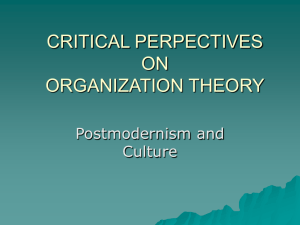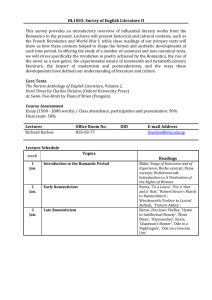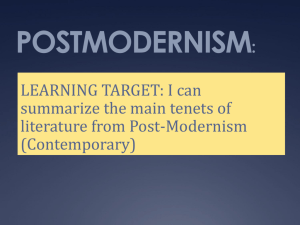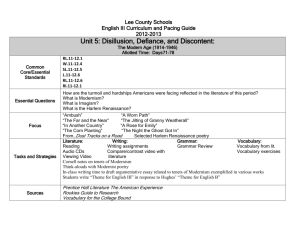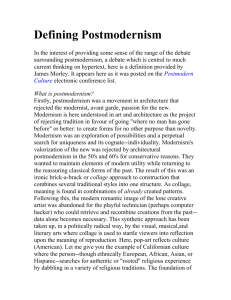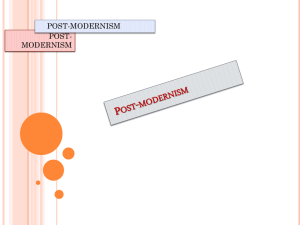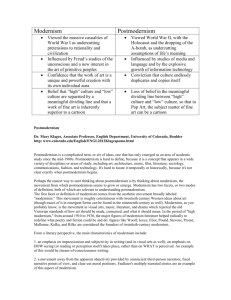Postmodernism was a development that came out
advertisement
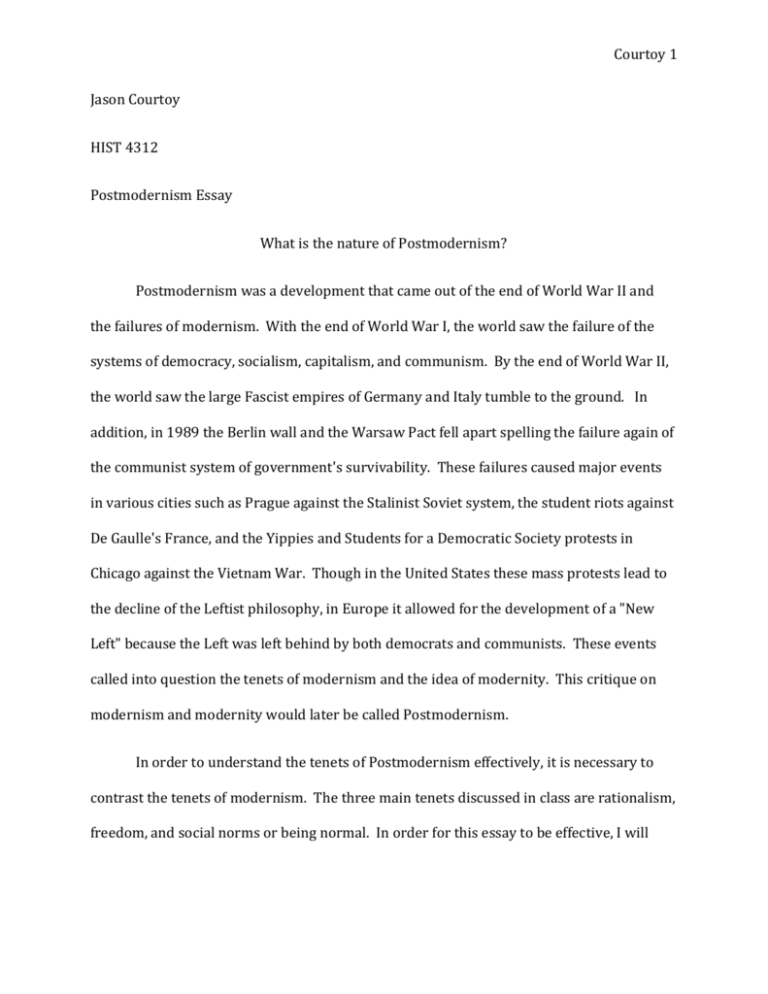
Courtoy 1 Jason Courtoy HIST 4312 Postmodernism Essay What is the nature of Postmodernism? Postmodernism was a development that came out of the end of World War II and the failures of modernism. With the end of World War I, the world saw the failure of the systems of democracy, socialism, capitalism, and communism. By the end of World War II, the world saw the large Fascist empires of Germany and Italy tumble to the ground. In addition, in 1989 the Berlin wall and the Warsaw Pact fell apart spelling the failure again of the communist system of government's survivability. These failures caused major events in various cities such as Prague against the Stalinist Soviet system, the student riots against De Gaulle's France, and the Yippies and Students for a Democratic Society protests in Chicago against the Vietnam War. Though in the United States these mass protests lead to the decline of the Leftist philosophy, in Europe it allowed for the development of a "New Left" because the Left was left behind by both democrats and communists. These events called into question the tenets of modernism and the idea of modernity. This critique on modernism and modernity would later be called Postmodernism. In order to understand the tenets of Postmodernism effectively, it is necessary to contrast the tenets of modernism. The three main tenets discussed in class are rationalism, freedom, and social norms or being normal. In order for this essay to be effective, I will Courtoy 2 remain with these three tenets but will expand upon these with the readings from Cahoone's book. In addition, I will explain the consequences of the Postmodernist critique. Rationalism, in modernism, is the ability for human and universal knowledge (i.e., the capital ‘T’ Truth) to figure things out. This comes in all forms, such as the ability of technology or science to understand all things. There is the creation of the ‘professional’ that is supposed to be objective or non-biased in his discovery of knowledge, and in teaching it. In Postmodernist's eyes, this is ridiculous; humans cannot find the capital ‘T’ Truth because it does not exist. There is no universal Truth. Jacques Derrida on her discourse on "Differance" explains that the problem with trying to understand Truth is that there are too many. The Postmodernist argument is that theories, such as the Big Bang Theory, are good answers, but they are just one amongst the many others and neither are better than the others. Michel Foucault explains that Truth is not universal because those in power control and manipulate the Truth. "Each society has its regime of truth, its 'general politics of truth." (Foucault 252) In "Nietzsche, Genealogy, History", Foucault attacks Rationalism in his three misuses of history. The point of his three misuses of history is that Rationalism says that professionals can be non-bias or neutral in their observations of their fields. Foucault attacks this by stating, "Knowledge does not slowly detach itself from its empirical roots, the initial needs from which it arose, to become pure speculation subject only to the demands of reason." (251) In this statement, he is saying that knowledge can never detach itself from the human perspective. Hilary Putnam in her essay "Is There Still Anything to Say About Reality and Truth?" goes over the idea of chair that has been discussed repeatedly in class. Her argument about Courtoy 3 chair starts with a simple math calculation. Objects calculated in one math system to another come out with the same right answer, but different results (e.g., that in base 10 math 10+10=20 but in base 5 10+10=40). His argument on the chair is that in the same world if a chair is colored (brown) or has certain properties (rectangular) then is it not a chair if the color is green and its square. Putnam states, "To require that all of these must be reducible to a single version is to make the mistake of supposing that 'Which are the real objects?' is a question that makes sense independently of our choice of concepts." (599) In other words, to limit that a chair is only a chair because it has such and such properties is a mistake. Moreover, we have to accept that there are other Truths, besides scientific knowledge or religion. Essential to modernism is freedom of the self, the ability of an individual to do things or figure things out by way of free will. Postmodernism rejects this in expressing the structuralist and post structuralist notion that everyone is part of mega-structure or overarching structure. Moreover, an overwhelming number of these various structures conform and shape one's actions to the point that free will is no longer attainable, since free will is determined by these structures. Thomas Kuhn's in "The Nature and Necessity of Scientific Revolutions" explains that the individual does not control science, instead it is the scientific community or structure that controls what science is. It is the community that decides whether a scientist becomes employed; is published; and how and what s/he studies. Jean-Francois Lyotard, in "The Postmodern Condition", examines the notion of the metanarrative or as he terms it the grand narratives. The purpose of the grand narrative is Courtoy 4 to legitimize the state, religious leaders, etc. He goes on to explain that after World War II with the failure of capitalism, communism, and fascism the grand narrative no longer supplied legitimacy to those in power. Essentially there is "no longer [a need for]...recourse to the grand narratives." (Lyotard 269) What replaces the metanarrative, in Lyotard's eyes, is power. The reason being that technology (which is the chief concern of industrial societies after World War II) is concerned chiefly with efficiency. Through technologies, creation, recreation, and redevelopment; power becomes a self-legitimizing force. Lyotard later combines technology and power together because they are so intertwined that he uses both interchangeably. The roles of science and power or technology are switched with the creation of greater ability to store data and connection of research with technology, power becomes dominate to science. Lyotard states "research funds are allocated by States, corporations, and nationalized companies in accordance with this logic of power growth." (269) The switch that he explains later on, between power being superior to science, is seen today in that scientists seek results faster and more efficiently as they strive for research grants. If scientists do not meet expectations or the deadline, their project is simply scrapped and the money goes elsewhere. Foucault in "Truth and Power" expresses this same link between power and Truth. "'Truth' is linked in a circular relation with systems of power which produce and sustain it, and to effects of power which it induces and which extend it. [This is] a regime of truth." (Foucault 253) This 'regime of truth' is meant to explain the connection that power has to truth. Truth is eternally linked with science it is the product of science and its institutions. Therefore the distinction between true and false, the rules that govern society are Truth. Essential to Foucault's argument is that power and truth are inseparable in their current Courtoy 5 understanding or state. Therefore, whoever controls power in society, whether that is a political leader, religious leader, corporation, etc, controls the capital “T” Truth, as well as what society sees as true and false. The only solution that he sees is to detach power from truth, but not from the whole system instead only from the "forms of hegemony" (Foucault 253). Social norms, as defined by sociology, are social behaviors that are expected to be adhered to by a member of a society. Modernism saw social norms as universal (e.g., in that British wanted to civilize the barbaric Germans); they felt that all social norms were universal in Western Europe. The Postmodernist explicitly say no this is cultural, though they would not say it exactly, but social norms are all relative. Social norms are controlled by the overarching structure of society. Therefore, whichever group is in power establishes what the social norms are. Most of this thought comes from the feminist thinkers of the time, but not entirely. Foucault in “Madness and Civilization” explains the history of insanity; how it developed, what it is, etc. In it, he establishes that insanity is a cultural definition because to be insane there has to be a definition of sane. The definition of sane or normalcy comes from the dominant culture defining what they see as normal behavior. Therefore, if public nudity is normal behavior then not being nude in public makes you insane. The development of the notion of insanity comes from the creation or building of the insane asylum, in the past those considered insane might be considered genius’ (e.g., Van Gogh, cutting his hear off). Luce Irigaray in “The Sex Which is Not One” explains that the dominant norm, that women should not be sexual, or the way in which they have sex (e.g., intercourse), is a Courtoy 6 masculine structure. She describes it, as “penis envy” (Irigaray 254), that the reason women are to be attracted to such a thing is that they envy not having one. She destroys this by identifying that women have multitudes of pleasure places, and like Hilary Putnam to limit women’s desires to just one area is to miss everything. The point Irigaray is making is that women are dominated by men, in what they are to do, how they are to act, etc all of which is defined by men. Her use of the allegorical notions of women’s sexual desires is only to show that women have no power within the system, their only means is to be slaves to a masochistic world. She points that to fix this, women must become active politically, stand for women’s rights, and separate themselves from men because only then can they become truly equal and separate from the dominant structure of masculinity. Iris Marion Young in “The Scaling of Bodies and the Politics of Identity” goes on from Irigaray’s concern with gender roles to attack the notion of ‘respectability. In this section, she describes two groups: the cultural imperialist group and the minorities. The key for her of understanding the cultural imperialist group is that they do not have to define themselves as part of the group (they are invisible). Her main relation in these groups is between genders (men and women), but she also holds that the cultural imperialist group perpetuates racism, ageism, etc. Young goes on to say that: Mosse shows how the virtues of respectability were primarily virtues of manliness. The primary virtue of manliness is self-mastery . . . [through this] only he who achieves [it] is truly rational, competent, and deserving of positions of authority. (373) The point Young is making is that to be respectable (both male and female) is to be manly or masculine. Bourgeois males define what social norms are and are not, and what is Courtoy 7 considered professional or respectable. One can see this today with the creation of the female business suit, in that it looks remarkably similar to a male business suit. Henry A. Giroux in his discourse on education, “Towards a Postmodern Pedagogy”, describes a remedy for American democracies lack of political and ethical education. He establishes nine points of what he termed “critical pedagogy” should be about. Four of these points are that: first, teaching needs to be understood as creating political adults; second, ethical discourse; third, teaching needs to be cynical or skeptical of anything that identifies itself as knowing the capital ‘T’ Truth; and fourth, a combination of feminist postmodernist concerns of racism, sexism, etc. His chief concern is that the social norm of the United States was one of political de-activism. His discourse on education was an attempt to fix the problem and to provide an example as to what could be provided to politically active regions like Post-communist Eastern Europe. Richard Rorty in “Solidarity or Objectivity?” expresses a defense of Liberal Democracy, much the same as Giroux does, but rather through the idea of solidarity or ‘usness’. This is a chief concern of Postmodernists, the since that we cannot fully know that there is a metaphysical, what we do have is ourselves or ‘us’. Rorty main addition to this discussion is that he sees no problem in absolute truths, mainly because he sees that in the future there might be better truths. Therefore, the notion is that it is all we know now (but it does not mean it is the true answer). The consequences of Postmodernism are various, but can all be summed up in one issue. Postmodernism’s rejection of the universal capital ‘T’ Truths in some aspects is good, but the problem is that Postmodernism leaves it as a void. Unlike other intellectual Courtoy 8 changes, Postmodernism does not provide a replacement for the loss of these absolute truths. This leaves each individual to define for himself what is true and false for him/her. This is detrimental to religious ideology in that it creates a pick and chose notion, that if one does not like that feature then do not follow it. This is problematic because then the purpose of religion is to justify oneself rather than to glorify or worship the metaphysical. This also leads to cultural issues and wars between what is true or false, serial killers like Ted Bundy or Timothy McVey might see their actions as the Truth and everyone else is wrong. The cultural war or what Samuel Huntington called the ‘Clash of Civilizations’, creates problems because everyone is right relatively. However, no one is wrong, except in the eyes of those other cultures. The major issue is that truths if left to human imagination are countless, and if humans are really left to a power struggle over structural control, then we really do live in a Hobbesian ‘State of Nature’. Courtoy 9 Works Citied Foucault, Michel. "Nietzsche, Genealogy, history." Cahoone, Lawrence. From Modernism to Postmodernism. Malden, MA: Blackwell Publishing, 2003. 251. Foucault, Michel. "Truth and Power." Cahoone, Lawrence. From Modernism to Postmodernism. Malden, MA: Blackwell Publishing, 2003. 252, 253. Irigaray, Luce. "The Sex Which is Not One." Cahoone, Lawrence. From Modernism to Postmodernism. Malden, MA: Blackwell Publishing, 2003. 254. Lyotard, Jean-Francois. "The Postmodern Condition: A Report on Knowledge." Cahoone, Lawrence. From Modernism to Postmodernism. Malden, MA: Blackwell Publishing, 2003. 269. Putnam, Hilary. "Is There Still Anything to Say about Reality and Truth?." Cahoone, Lawrence. From Modernism to Postmodernism. Malden, MA: Blackwell Publishing, 2003. 599. Young, Iris Marion. "The Scaling of Bodies and the Politics of Identity." Cahoone, Lawrence. From Modernism to Postmodernism. Malden, MA: Blackwell Publishing, 2003. 373.
